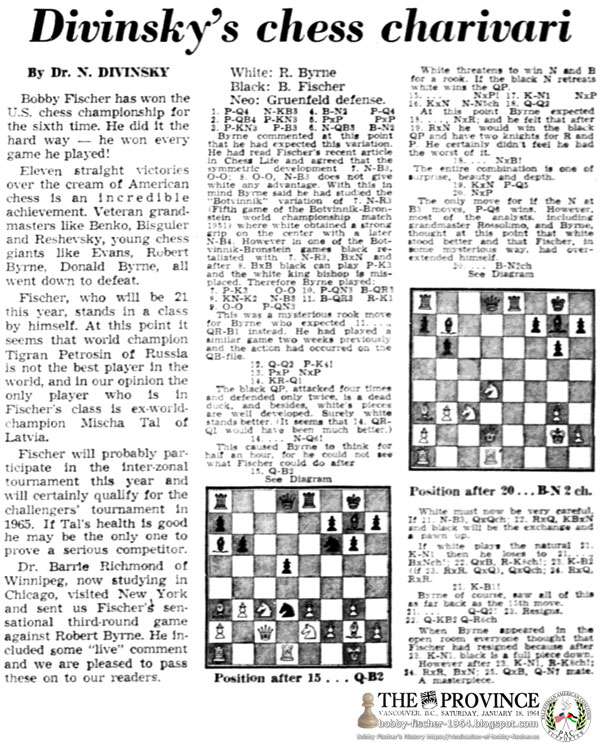The Province Vancouver, British Columbia, Canada Saturday, January 18, 1964 - Page 66
Divinsky's Chess Charivari
By Dr. N. Divinsky
Bobby Fischer has won the U.S. chess championship for the sixth time. He did it the hard way - he won every game he played!
Eleven straight victories over the cream of American chess is an incredible achievement. Veteran grandmasters like Benko, Bisguier and Reshevsky, young chess giants like Evans, Robert Byrne, Donald Byrne, all went down to defeat.
Fischer, who will be 21 this year, stands in a class by himself. At this point it seems that world champion Tigran Petrosian of Russia is not the best player in the world, and in our opinion the only player who is in Fischer's class is ex-world-champion Mischa Tal of Latvia.
Fischer will probably participate in the inter-zonal tournament this year and will certainly qualify for the challengers' tournament in 1965. If Tal's health is good he may be the only one to prove a serious competitor.
Dr. Barrie Richmond of Winnipeg, now studying in Chicago, visited New York and sent us Fischer's sensational third-round game against Robert Byrne. He included some “live” comment and we are pleased to pass these on to our readers.
White: R. Byrne
Black: B. Fischer
Neo: Gruenfeld defense
1. P-Q4 N-KB3
2. P-QB4 P-KN3
3. P-KN3 P-B3
4. B-N2 P-Q4
5. PxP PxP
6. N-QB3 B-N2
Byrne commented at this point that be had expected this variation. He had read Fischer's recent article in Chess Life and agreed that the symmetric development
7. N-B3, O-O;
8. O-O, N-B3 does not give white any advantage. With this in mind Byrne said be had studied the “Botvinnik” variation of 7. N-R3 (Fifth game of the Botvinnik-Bronstein world championship match; 1951) where white obtained a strong grip on the center with a later N-B4. However in one of the Botvinnik-Bronstein games black retaliated with 7. N-R3, BxN and after 8. BxB black can play P-K3, and the white king bishop is misplaced. Therefore Byrne played:
7. P-K3 O-O
8. KN-K2 N-B3
9. O-O P-QN3
10. P-QN3 B-QR3
11. B-QR3 R-K1
This was a mysterious rook move for Byrne who expected 11…QR-B1 instead. He had played a similar game two weeks previously and the action had occurred on the QB-file.
12. Q-Q2 P-K4!
13. PxP NxP
14. KR-Q1
The black QP, attacked four times and defended only twice, is a dead duck, and besides, white's pieces are well developed. Surely white stands better. (It seems that 14. QR-Q1 would have been much better.)
14… N-Q6!
This caused Byrne to think for half an hour, for he could not see what Fischer could do after
15. Q-B2
See Diagram.
Position after 15…Q-B2
White threatens to win N and B for a rook. If the black N retreats white wins the QP.
15. … NxP!
16. KxN N-N5ch
17. K-N1 NxP
18. Q-Q2
At this point Byrne expected
18 … NxR; and he felt that after
19. RxN he would win the black QP and have two knights for R and P. He certainly didn't feel he had the worst of it.
18. … NxB!
The entire combination is one of surprise, beauty and depth.
19. KxN P-Q5
20. NxP
The only move for it the N at B3 moves, P-Q6 wins. However, most of the analysts, including grandmaster Rossolimo, and Byrne, thought at this point that white stood better and that Fischer, in some mysterious way, had overextended himself.
20 … B-N2ch
See Diagram.
Position after 20…B-N2 ch.
White must now be very careful. If 21. N-B3, QxQch; 22. RxQ, KBxN and black will be the exchange and a pawn up.
If white plays the natural 21. K-N1 then he loses to 21 … BxNch!; 22. QxB, R-K8ch!; 23. K-B2 (if 23. RxR, QxQ), QxQch; 24. RxQ, RxR.
21. K-B1!
Byrne of course, saw all of this as far back as the 15th move.
21 … Q-Q2!
22. Q-KB2 Q-R6ch
23. Resigns.
When Byrne appeared in the open room everyone thought that Fischer had resigned because after 23. K-N1, black is a full piece down.
However after 23. K-N1, R-K8ch1; 24. RxR, BxN; 25. QxB, QN7 mate.
A masterpiece.























